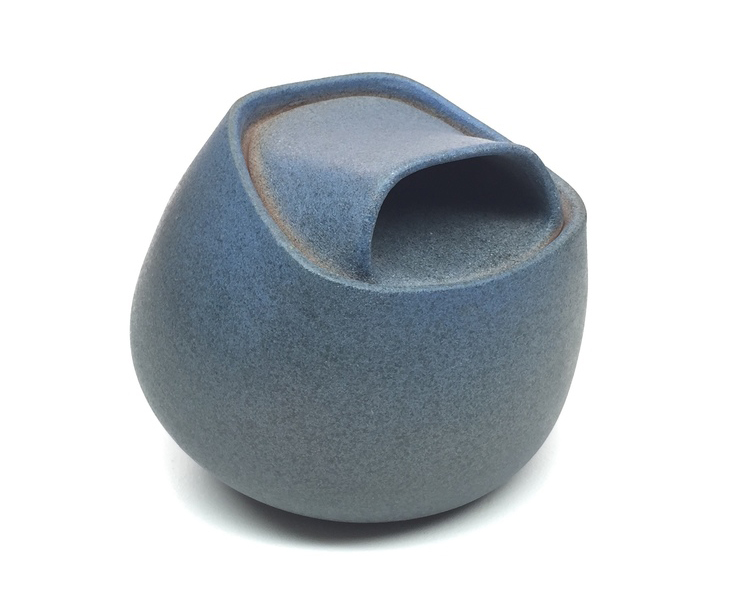Noah Riedel approaches his ceramic design with without preconceptions of the rules of the material. Expected traits of functional-ware are missing from his practice, the glossy surfaces, solid fluid colors, and even typical production methods. I don’t imagine Riedel has anything against them, he’s just found a better way. The result of his objective approach to ceramic process is a unique and diverse aesthetic experience rarely achieved in functional pottery.
Riedel received his BA from University of North Carolina Wilmington in 2002, followed by a Post-Baccalaureate at Central Carolina Community College, and a 2-year apprenticeship with potter Mark Hewitt. He attended residencies in Seattle; WA, Kansas City; MO, and Skaelskor; Denmark and in 2009 launched Biloya ceramic design, the company he produces work under today. Riedel currently works out of out of Studio 740 in Helena, Montana, in the company of fellow all-star ceramicists Beth Cavener, Alessandro Gallo.
Riedel’s designs are beautiful because they are excruciatingly (but deceptively) simple. The viewer is not surprised when the form makes a turn, or when the color of the surface changes. All of this is anticipated visually through a slow seamless curve or a gradual gradated surface. This soothing visual explanation of design and usability is something that you might never notice, but it improves your life immensely. The experience requires no thought because it is, simply, known. This is user experience at its best. Like when the overhead light in your car fades out slowly, or when the kitchen drawers at IKEA retreat in the most gentle way possible. It’s a relief to know that your dinnerware is concerned about the quality of your life.
It is easy to see that Riedel is a minimalist. Even his process has been refined to make his life simpler, so that he, like the consumer, can focus on what’s more pressing in life. In Riedel’s case, that seems to be a quest of refining, creating, and designing more work.
Riedel explains his process: “I once-fire everything. Liner glazes inside (formulated for raw glazing at the leather hard stage). The outer surfaces are thinly sprayed layers of terra sigs, slips, engobes, and pure fluxes. Every pot gets at least 3 layers of some combination of those, most get many more. Everything is midrange stoneware, fired to cone 5 in an electric kiln.”
His process is brilliant because it eliminates surprises when opening the kiln. Everything comes out looking similar to how it went in, a strange concept in the functional ceramics realm. Of course, Riedel worked incredibly hard to craft this perfect formulaic process, and judging by his rapid refinement of form and surfaces over the last few years, he has not let up in the least.
His process is explained perfectly in his somewhat cold, short, language, but don’t let that fool you into thinking he is lacking in romance for clay. Everything is constructed by hand, not slip-cast like your typical ceramic design-ware. Most “purely designer’s” passion lies in the designing process: the drawing, the prototypes, the slight variations. The act of making is often seen as uninteresting, so outsourced or expedited. This is what makes Riedel’s practice so fascinating; he is clearly passionate about both designing and making. This dual passion results in finished work that is perfectly refined like a product, but unique like a handmade object. It is rare and striking to encounter a product imbued with a reflection of humanness. Because, even though the tool marks, brushstrokes, and imperfections have been polished away, his designs radiate with experimentation, creativity, and life.
Noah Riedel has managed to stay under the radar of the ceramic design world, but this recent work proves he is an artist on the verge. A maker to watch closely in near future.
Justin Crowe is a Writer and Director of Operations at CFile.
What do you think of Noah Riedel’s smooth functional designs? Tell us in the comments below!



















I have a few pieces marked “Riedel” from Peterborough Art Pottery from Ontario Canada with beautiful simple lines and depicting Petroglyphs from near where I grew up in a place called Nephton which supplied the white found in this profound pottery, with the refining mineral called Nepheline (very rare world wide as they are only 3 known deposits) . Wonder if Noah is related to this “Riedel” . His forms look very much like the pottery I have in my small collection. Love Riedel where ever they are!!
Finally a potter who steps into the 21st Century with work at once eloquent and elegant while remaining distinctively his own. He remains one of my favorite “driven” personalities in this small field. Make more Noah!
I love Noah’s work. I met him about 5 years ago when I was Gallery Director at FRANKgallery in Chapel Hill. I loved whenever he brought in his new work and we’d talk about the pieces. His work is quiet and elegant and it’s meant to be touched in a way described by the use of the piece. I have several of his pieces and I never get used to seeing them.
I love the deceptively simple designs, so organic in form and reminiscent of Japanese Ceramics. The glazes fit like a glove on your hand.
Lovely to see Noah’s uncompromisingly sly and stylish work featured here. He solves riddles and bends lines, squeezing eloquence from simplicity.
Noah is a brilliant designer and maker. I got to know him when he was an artist in residence at Pottery Northwest in Seattle for two years. Nice gentle understated . . . pots and the man. So glad he has gotten this recognition. I use one of his perforated bowls every day. Best fruit bowl in the world.